Hospitality Business Toolkit Report: Financial, HR, and Legal Aspects
VerifiedAdded on 2020/11/23
|16
|3354
|200
Report
AI Summary
This report provides a comprehensive overview of the hospitality business toolkit, focusing on key aspects such as financial management, human resources, and legal compliance. It begins with an introduction to the hospitality industry and the establishment of "Taste and Twist," a new business in London, UK. The report then delves into financial performance, including key financial statements, inventory management, and overhead analysis. It explores the application of the double-entry bookkeeping system and the creation of a trial balance. The HR section examines the HR life cycle stages and performance management plans, including talent acquisition and strategies for addressing employee performance issues. The report also addresses specific legislations that Taste and Twist must comply with, as well as the impact of company, employment, and contract law on the business. Finally, it explores the interrelation of functional roles within the hospitality industry and methods of communication and coordination to strengthen the value chain. The report concludes with a summary of the key findings and recommendations for Taste and Twist.
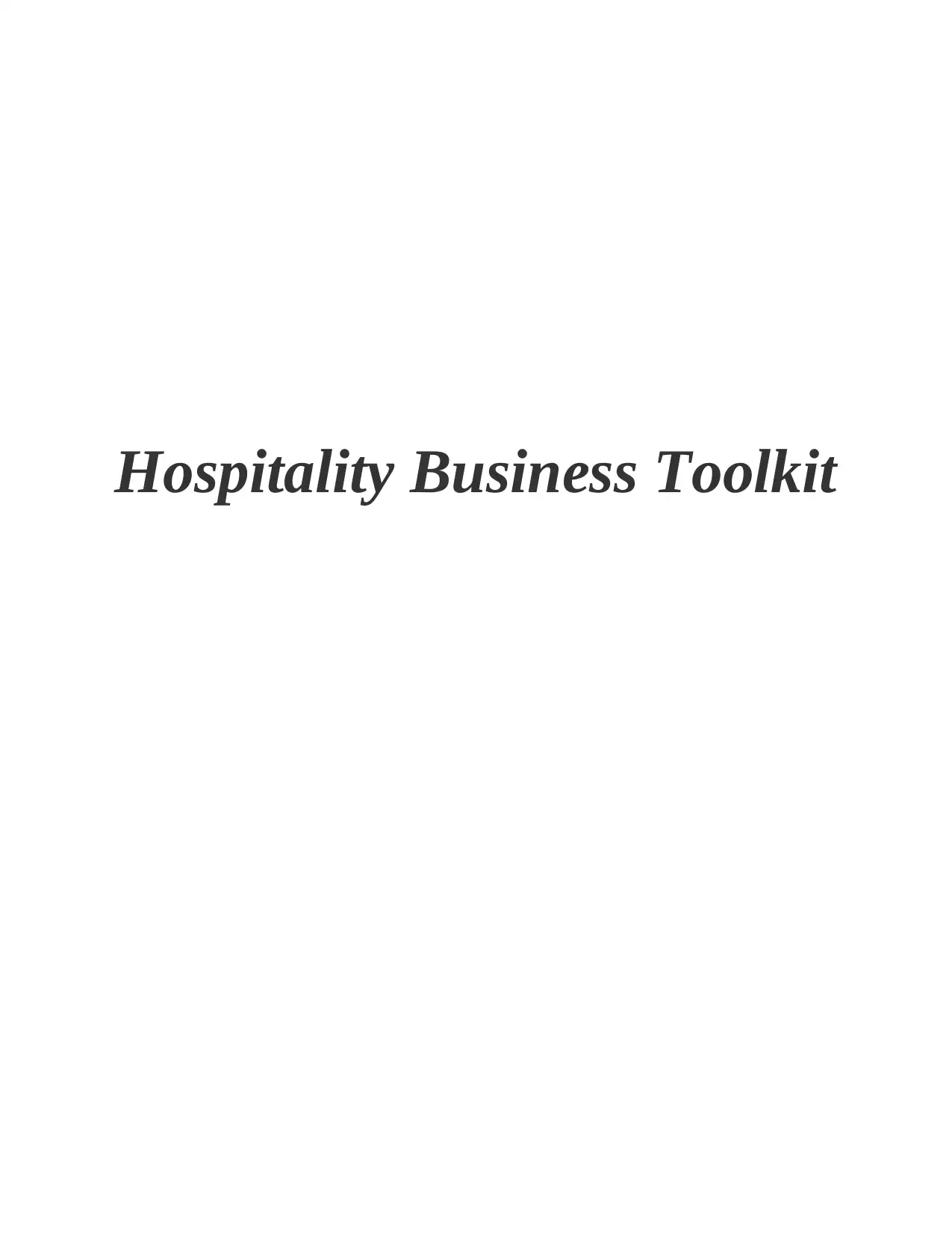
Hospitality Business Toolkit
Paraphrase This Document
Need a fresh take? Get an instant paraphrase of this document with our AI Paraphraser
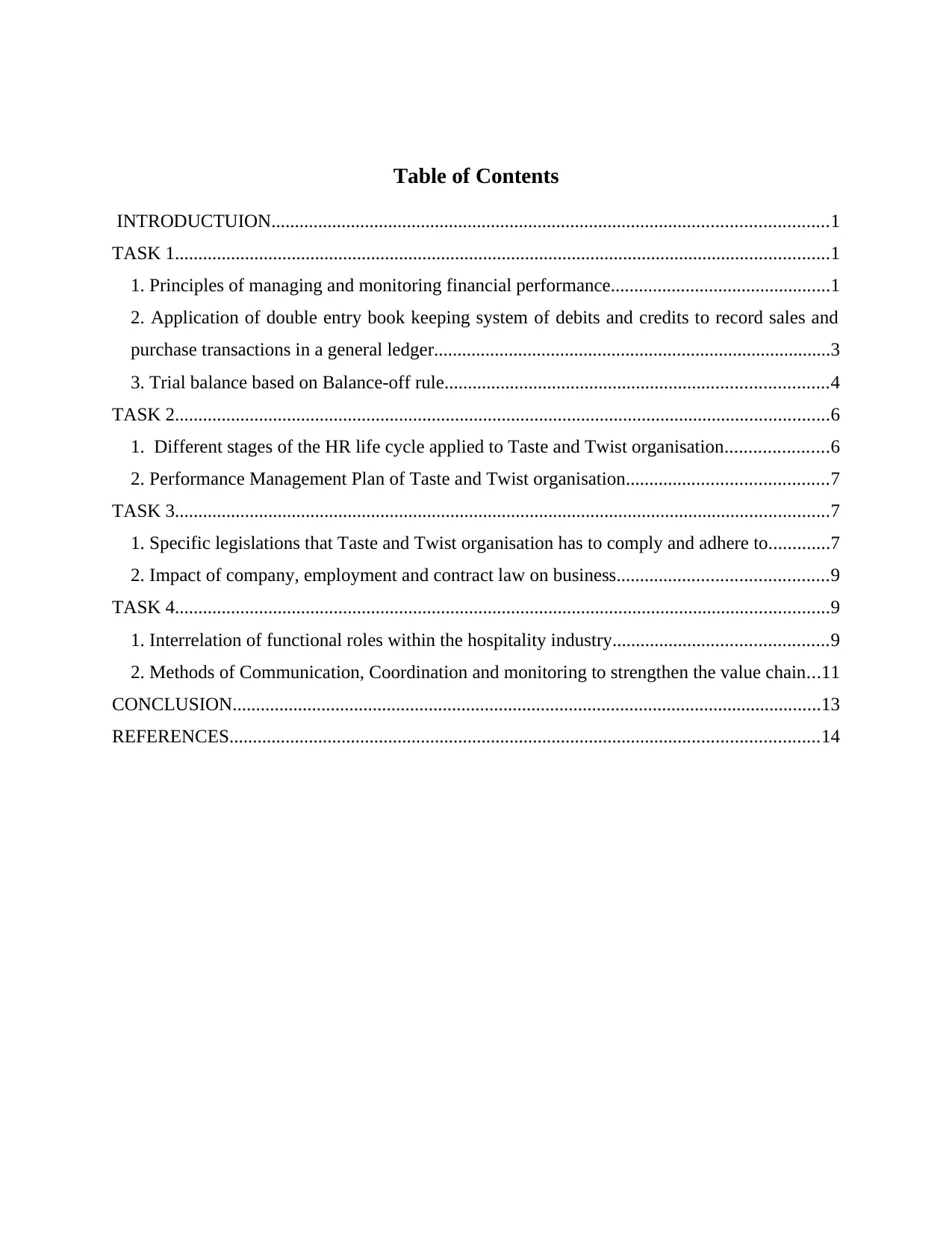
Table of Contents
INTRODUCTUION.......................................................................................................................1
TASK 1............................................................................................................................................1
1. Principles of managing and monitoring financial performance...............................................1
2. Application of double entry book keeping system of debits and credits to record sales and
purchase transactions in a general ledger.....................................................................................3
3. Trial balance based on Balance-off rule..................................................................................4
TASK 2............................................................................................................................................6
1. Different stages of the HR life cycle applied to Taste and Twist organisation......................6
2. Performance Management Plan of Taste and Twist organisation...........................................7
TASK 3............................................................................................................................................7
1. Specific legislations that Taste and Twist organisation has to comply and adhere to.............7
2. Impact of company, employment and contract law on business.............................................9
TASK 4............................................................................................................................................9
1. Interrelation of functional roles within the hospitality industry..............................................9
2. Methods of Communication, Coordination and monitoring to strengthen the value chain...11
CONCLUSION..............................................................................................................................13
REFERENCES..............................................................................................................................14
INTRODUCTUION.......................................................................................................................1
TASK 1............................................................................................................................................1
1. Principles of managing and monitoring financial performance...............................................1
2. Application of double entry book keeping system of debits and credits to record sales and
purchase transactions in a general ledger.....................................................................................3
3. Trial balance based on Balance-off rule..................................................................................4
TASK 2............................................................................................................................................6
1. Different stages of the HR life cycle applied to Taste and Twist organisation......................6
2. Performance Management Plan of Taste and Twist organisation...........................................7
TASK 3............................................................................................................................................7
1. Specific legislations that Taste and Twist organisation has to comply and adhere to.............7
2. Impact of company, employment and contract law on business.............................................9
TASK 4............................................................................................................................................9
1. Interrelation of functional roles within the hospitality industry..............................................9
2. Methods of Communication, Coordination and monitoring to strengthen the value chain...11
CONCLUSION..............................................................................................................................13
REFERENCES..............................................................................................................................14
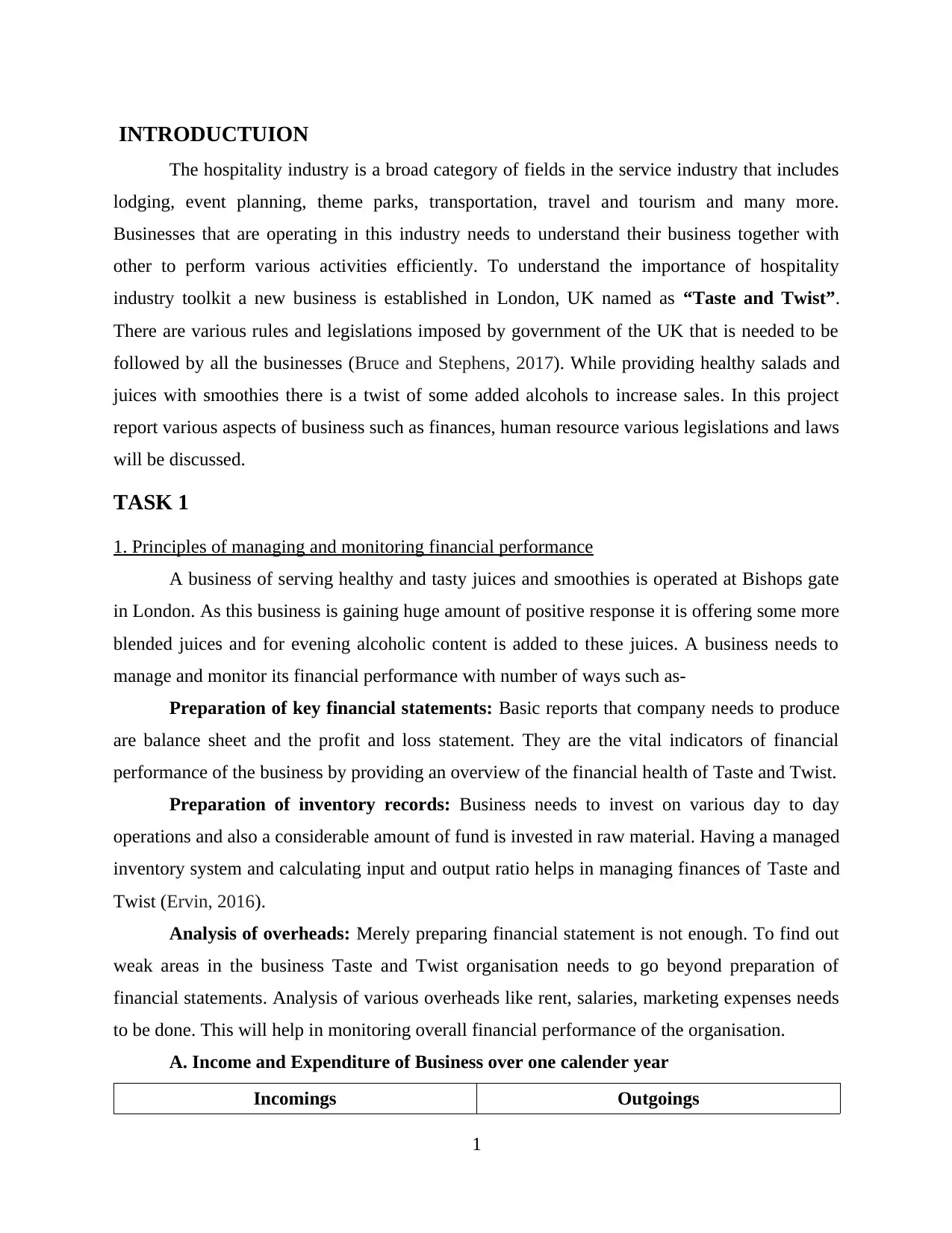
INTRODUCTUION
The hospitality industry is a broad category of fields in the service industry that includes
lodging, event planning, theme parks, transportation, travel and tourism and many more.
Businesses that are operating in this industry needs to understand their business together with
other to perform various activities efficiently. To understand the importance of hospitality
industry toolkit a new business is established in London, UK named as “Taste and Twist”.
There are various rules and legislations imposed by government of the UK that is needed to be
followed by all the businesses (Bruce and Stephens, 2017). While providing healthy salads and
juices with smoothies there is a twist of some added alcohols to increase sales. In this project
report various aspects of business such as finances, human resource various legislations and laws
will be discussed.
TASK 1
1. Principles of managing and monitoring financial performance
A business of serving healthy and tasty juices and smoothies is operated at Bishops gate
in London. As this business is gaining huge amount of positive response it is offering some more
blended juices and for evening alcoholic content is added to these juices. A business needs to
manage and monitor its financial performance with number of ways such as-
Preparation of key financial statements: Basic reports that company needs to produce
are balance sheet and the profit and loss statement. They are the vital indicators of financial
performance of the business by providing an overview of the financial health of Taste and Twist.
Preparation of inventory records: Business needs to invest on various day to day
operations and also a considerable amount of fund is invested in raw material. Having a managed
inventory system and calculating input and output ratio helps in managing finances of Taste and
Twist (Ervin, 2016).
Analysis of overheads: Merely preparing financial statement is not enough. To find out
weak areas in the business Taste and Twist organisation needs to go beyond preparation of
financial statements. Analysis of various overheads like rent, salaries, marketing expenses needs
to be done. This will help in monitoring overall financial performance of the organisation.
A. Income and Expenditure of Business over one calender year
Incomings Outgoings
1
The hospitality industry is a broad category of fields in the service industry that includes
lodging, event planning, theme parks, transportation, travel and tourism and many more.
Businesses that are operating in this industry needs to understand their business together with
other to perform various activities efficiently. To understand the importance of hospitality
industry toolkit a new business is established in London, UK named as “Taste and Twist”.
There are various rules and legislations imposed by government of the UK that is needed to be
followed by all the businesses (Bruce and Stephens, 2017). While providing healthy salads and
juices with smoothies there is a twist of some added alcohols to increase sales. In this project
report various aspects of business such as finances, human resource various legislations and laws
will be discussed.
TASK 1
1. Principles of managing and monitoring financial performance
A business of serving healthy and tasty juices and smoothies is operated at Bishops gate
in London. As this business is gaining huge amount of positive response it is offering some more
blended juices and for evening alcoholic content is added to these juices. A business needs to
manage and monitor its financial performance with number of ways such as-
Preparation of key financial statements: Basic reports that company needs to produce
are balance sheet and the profit and loss statement. They are the vital indicators of financial
performance of the business by providing an overview of the financial health of Taste and Twist.
Preparation of inventory records: Business needs to invest on various day to day
operations and also a considerable amount of fund is invested in raw material. Having a managed
inventory system and calculating input and output ratio helps in managing finances of Taste and
Twist (Ervin, 2016).
Analysis of overheads: Merely preparing financial statement is not enough. To find out
weak areas in the business Taste and Twist organisation needs to go beyond preparation of
financial statements. Analysis of various overheads like rent, salaries, marketing expenses needs
to be done. This will help in monitoring overall financial performance of the organisation.
A. Income and Expenditure of Business over one calender year
Incomings Outgoings
1
⊘ This is a preview!⊘
Do you want full access?
Subscribe today to unlock all pages.

Trusted by 1+ million students worldwide
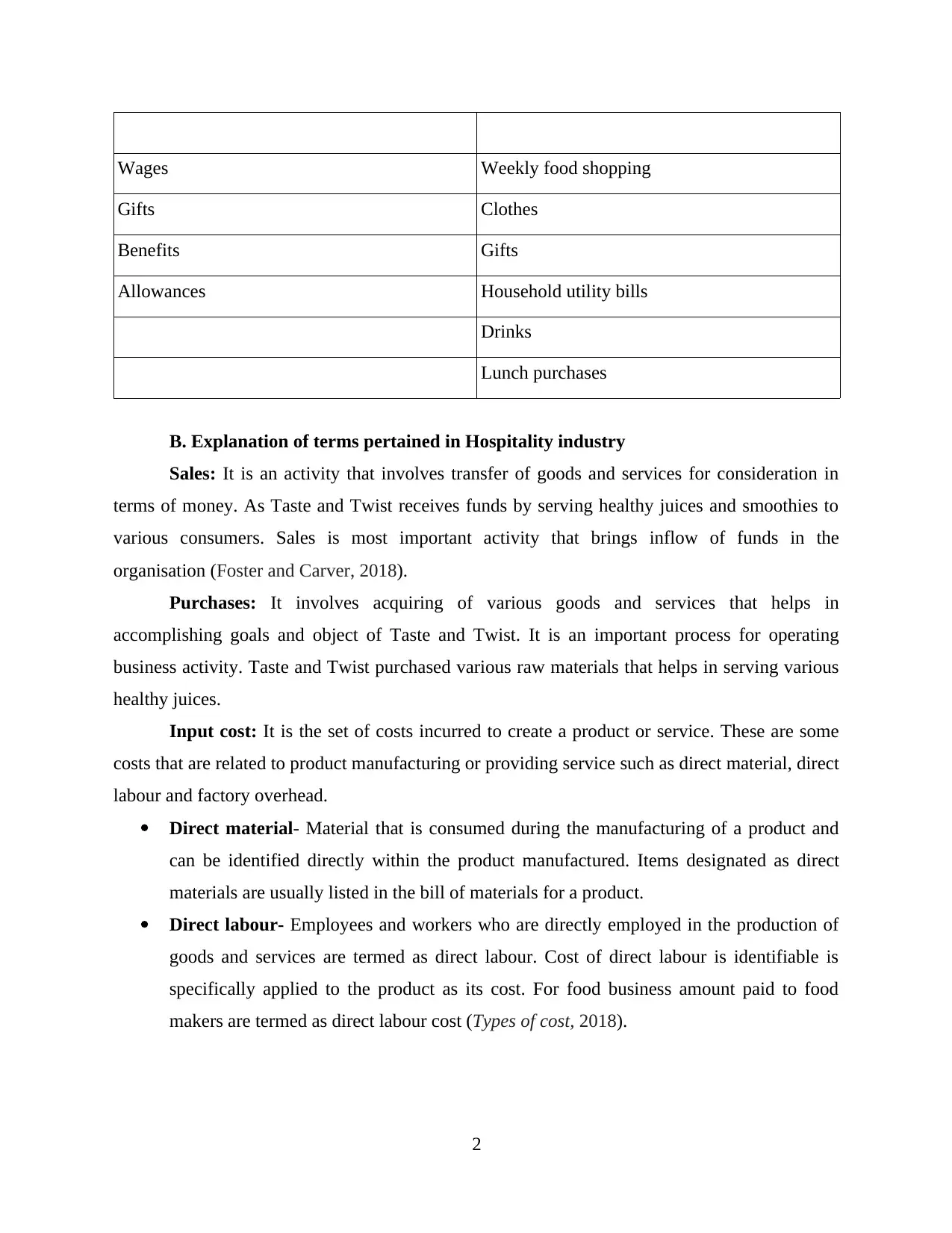
Wages Weekly food shopping
Gifts Clothes
Benefits Gifts
Allowances Household utility bills
Drinks
Lunch purchases
B. Explanation of terms pertained in Hospitality industry
Sales: It is an activity that involves transfer of goods and services for consideration in
terms of money. As Taste and Twist receives funds by serving healthy juices and smoothies to
various consumers. Sales is most important activity that brings inflow of funds in the
organisation (Foster and Carver, 2018).
Purchases: It involves acquiring of various goods and services that helps in
accomplishing goals and object of Taste and Twist. It is an important process for operating
business activity. Taste and Twist purchased various raw materials that helps in serving various
healthy juices.
Input cost: It is the set of costs incurred to create a product or service. These are some
costs that are related to product manufacturing or providing service such as direct material, direct
labour and factory overhead.
Direct material- Material that is consumed during the manufacturing of a product and
can be identified directly within the product manufactured. Items designated as direct
materials are usually listed in the bill of materials for a product.
Direct labour- Employees and workers who are directly employed in the production of
goods and services are termed as direct labour. Cost of direct labour is identifiable is
specifically applied to the product as its cost. For food business amount paid to food
makers are termed as direct labour cost (Types of cost, 2018).
2
Gifts Clothes
Benefits Gifts
Allowances Household utility bills
Drinks
Lunch purchases
B. Explanation of terms pertained in Hospitality industry
Sales: It is an activity that involves transfer of goods and services for consideration in
terms of money. As Taste and Twist receives funds by serving healthy juices and smoothies to
various consumers. Sales is most important activity that brings inflow of funds in the
organisation (Foster and Carver, 2018).
Purchases: It involves acquiring of various goods and services that helps in
accomplishing goals and object of Taste and Twist. It is an important process for operating
business activity. Taste and Twist purchased various raw materials that helps in serving various
healthy juices.
Input cost: It is the set of costs incurred to create a product or service. These are some
costs that are related to product manufacturing or providing service such as direct material, direct
labour and factory overhead.
Direct material- Material that is consumed during the manufacturing of a product and
can be identified directly within the product manufactured. Items designated as direct
materials are usually listed in the bill of materials for a product.
Direct labour- Employees and workers who are directly employed in the production of
goods and services are termed as direct labour. Cost of direct labour is identifiable is
specifically applied to the product as its cost. For food business amount paid to food
makers are termed as direct labour cost (Types of cost, 2018).
2
Paraphrase This Document
Need a fresh take? Get an instant paraphrase of this document with our AI Paraphraser
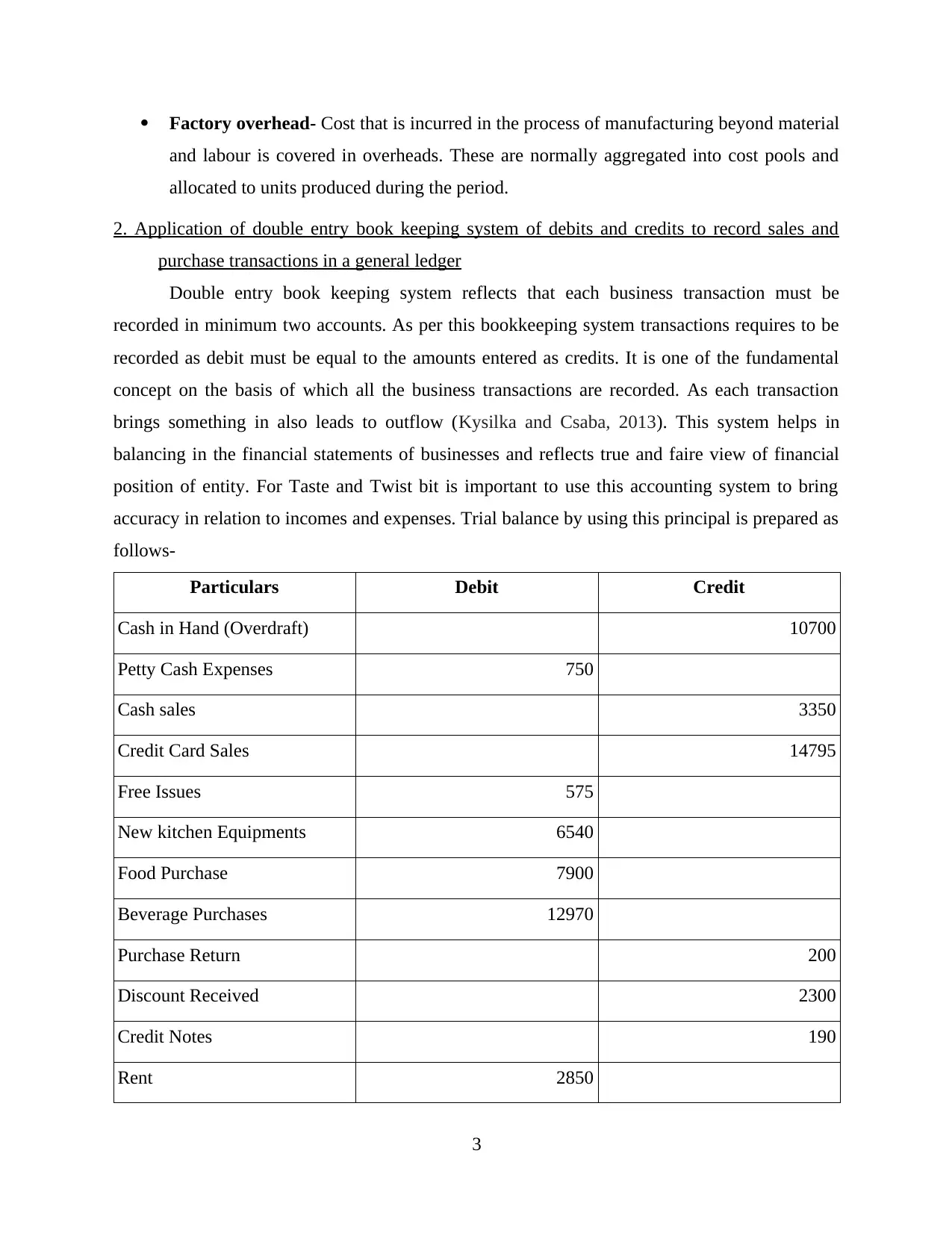
Factory overhead- Cost that is incurred in the process of manufacturing beyond material
and labour is covered in overheads. These are normally aggregated into cost pools and
allocated to units produced during the period.
2. Application of double entry book keeping system of debits and credits to record sales and
purchase transactions in a general ledger
Double entry book keeping system reflects that each business transaction must be
recorded in minimum two accounts. As per this bookkeeping system transactions requires to be
recorded as debit must be equal to the amounts entered as credits. It is one of the fundamental
concept on the basis of which all the business transactions are recorded. As each transaction
brings something in also leads to outflow (Kysilka and Csaba, 2013). This system helps in
balancing in the financial statements of businesses and reflects true and faire view of financial
position of entity. For Taste and Twist bit is important to use this accounting system to bring
accuracy in relation to incomes and expenses. Trial balance by using this principal is prepared as
follows-
Particulars Debit Credit
Cash in Hand (Overdraft) 10700
Petty Cash Expenses 750
Cash sales 3350
Credit Card Sales 14795
Free Issues 575
New kitchen Equipments 6540
Food Purchase 7900
Beverage Purchases 12970
Purchase Return 200
Discount Received 2300
Credit Notes 190
Rent 2850
3
and labour is covered in overheads. These are normally aggregated into cost pools and
allocated to units produced during the period.
2. Application of double entry book keeping system of debits and credits to record sales and
purchase transactions in a general ledger
Double entry book keeping system reflects that each business transaction must be
recorded in minimum two accounts. As per this bookkeeping system transactions requires to be
recorded as debit must be equal to the amounts entered as credits. It is one of the fundamental
concept on the basis of which all the business transactions are recorded. As each transaction
brings something in also leads to outflow (Kysilka and Csaba, 2013). This system helps in
balancing in the financial statements of businesses and reflects true and faire view of financial
position of entity. For Taste and Twist bit is important to use this accounting system to bring
accuracy in relation to incomes and expenses. Trial balance by using this principal is prepared as
follows-
Particulars Debit Credit
Cash in Hand (Overdraft) 10700
Petty Cash Expenses 750
Cash sales 3350
Credit Card Sales 14795
Free Issues 575
New kitchen Equipments 6540
Food Purchase 7900
Beverage Purchases 12970
Purchase Return 200
Discount Received 2300
Credit Notes 190
Rent 2850
3
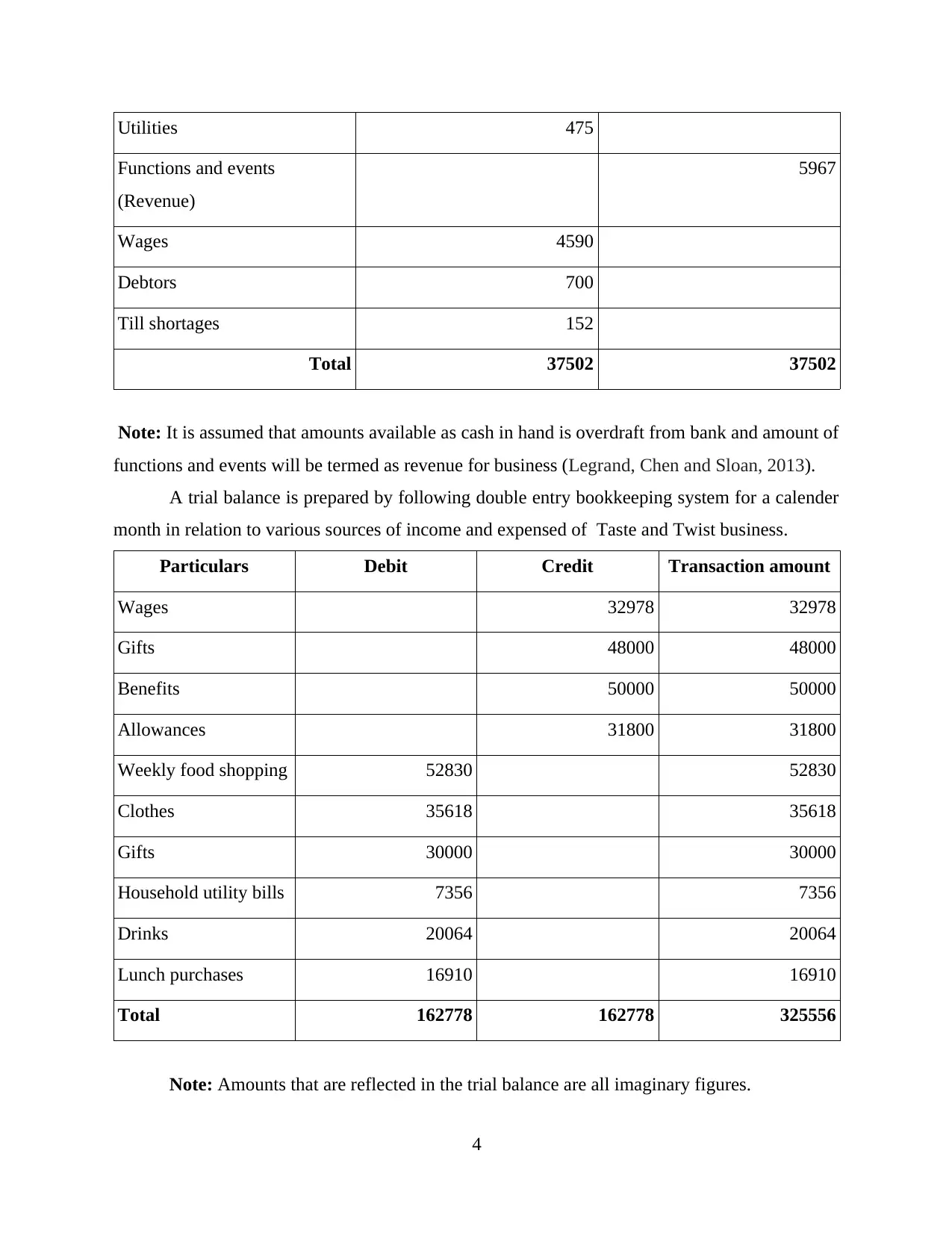
Utilities 475
Functions and events
(Revenue)
5967
Wages 4590
Debtors 700
Till shortages 152
Total 37502 37502
Note: It is assumed that amounts available as cash in hand is overdraft from bank and amount of
functions and events will be termed as revenue for business (Legrand, Chen and Sloan, 2013).
A trial balance is prepared by following double entry bookkeeping system for a calender
month in relation to various sources of income and expensed of Taste and Twist business.
Particulars Debit Credit Transaction amount
Wages 32978 32978
Gifts 48000 48000
Benefits 50000 50000
Allowances 31800 31800
Weekly food shopping 52830 52830
Clothes 35618 35618
Gifts 30000 30000
Household utility bills 7356 7356
Drinks 20064 20064
Lunch purchases 16910 16910
Total 162778 162778 325556
Note: Amounts that are reflected in the trial balance are all imaginary figures.
4
Functions and events
(Revenue)
5967
Wages 4590
Debtors 700
Till shortages 152
Total 37502 37502
Note: It is assumed that amounts available as cash in hand is overdraft from bank and amount of
functions and events will be termed as revenue for business (Legrand, Chen and Sloan, 2013).
A trial balance is prepared by following double entry bookkeeping system for a calender
month in relation to various sources of income and expensed of Taste and Twist business.
Particulars Debit Credit Transaction amount
Wages 32978 32978
Gifts 48000 48000
Benefits 50000 50000
Allowances 31800 31800
Weekly food shopping 52830 52830
Clothes 35618 35618
Gifts 30000 30000
Household utility bills 7356 7356
Drinks 20064 20064
Lunch purchases 16910 16910
Total 162778 162778 325556
Note: Amounts that are reflected in the trial balance are all imaginary figures.
4
⊘ This is a preview!⊘
Do you want full access?
Subscribe today to unlock all pages.

Trusted by 1+ million students worldwide
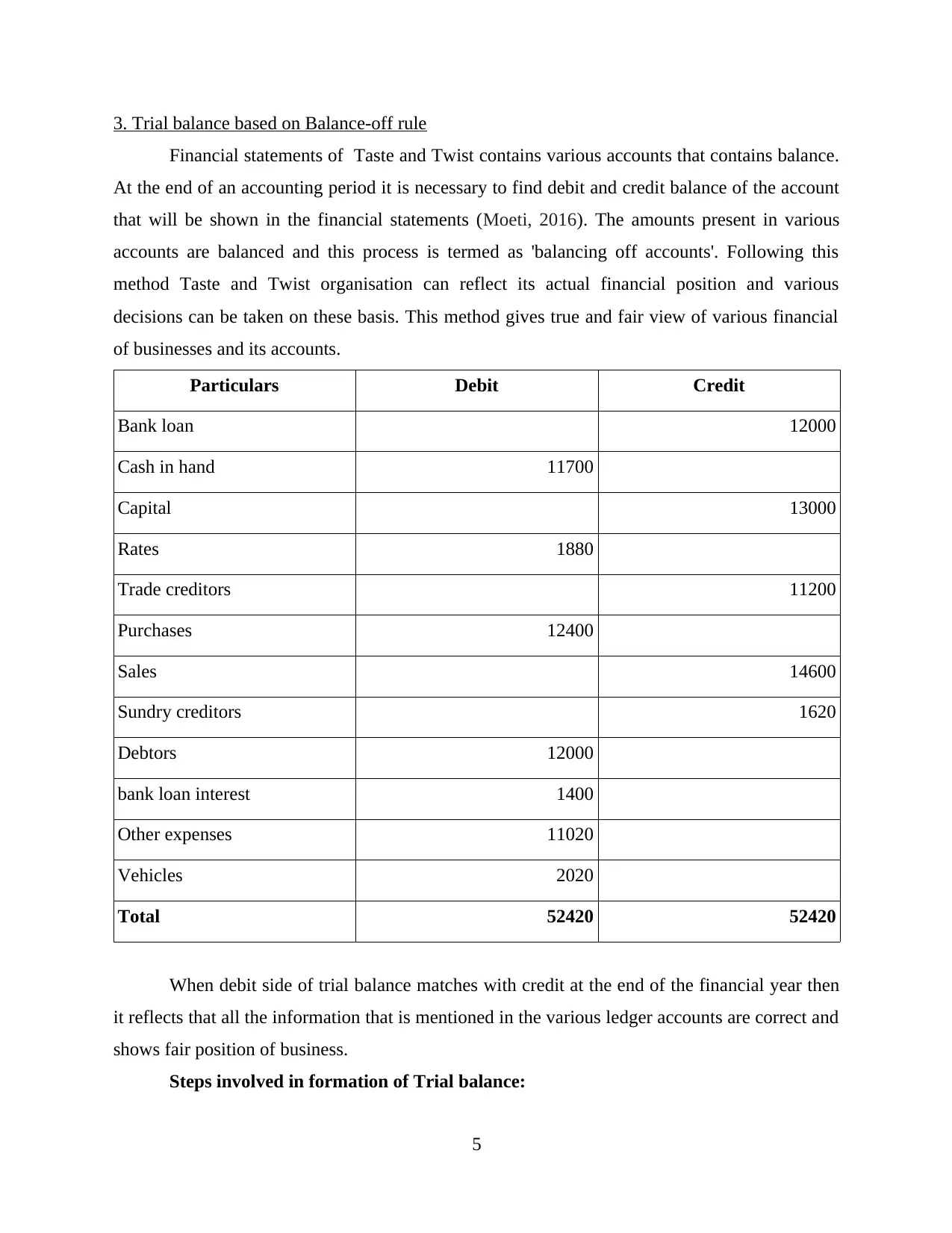
3. Trial balance based on Balance-off rule
Financial statements of Taste and Twist contains various accounts that contains balance.
At the end of an accounting period it is necessary to find debit and credit balance of the account
that will be shown in the financial statements (Moeti, 2016). The amounts present in various
accounts are balanced and this process is termed as 'balancing off accounts'. Following this
method Taste and Twist organisation can reflect its actual financial position and various
decisions can be taken on these basis. This method gives true and fair view of various financial
of businesses and its accounts.
Particulars Debit Credit
Bank loan 12000
Cash in hand 11700
Capital 13000
Rates 1880
Trade creditors 11200
Purchases 12400
Sales 14600
Sundry creditors 1620
Debtors 12000
bank loan interest 1400
Other expenses 11020
Vehicles 2020
Total 52420 52420
When debit side of trial balance matches with credit at the end of the financial year then
it reflects that all the information that is mentioned in the various ledger accounts are correct and
shows fair position of business.
Steps involved in formation of Trial balance:
5
Financial statements of Taste and Twist contains various accounts that contains balance.
At the end of an accounting period it is necessary to find debit and credit balance of the account
that will be shown in the financial statements (Moeti, 2016). The amounts present in various
accounts are balanced and this process is termed as 'balancing off accounts'. Following this
method Taste and Twist organisation can reflect its actual financial position and various
decisions can be taken on these basis. This method gives true and fair view of various financial
of businesses and its accounts.
Particulars Debit Credit
Bank loan 12000
Cash in hand 11700
Capital 13000
Rates 1880
Trade creditors 11200
Purchases 12400
Sales 14600
Sundry creditors 1620
Debtors 12000
bank loan interest 1400
Other expenses 11020
Vehicles 2020
Total 52420 52420
When debit side of trial balance matches with credit at the end of the financial year then
it reflects that all the information that is mentioned in the various ledger accounts are correct and
shows fair position of business.
Steps involved in formation of Trial balance:
5
Paraphrase This Document
Need a fresh take? Get an instant paraphrase of this document with our AI Paraphraser
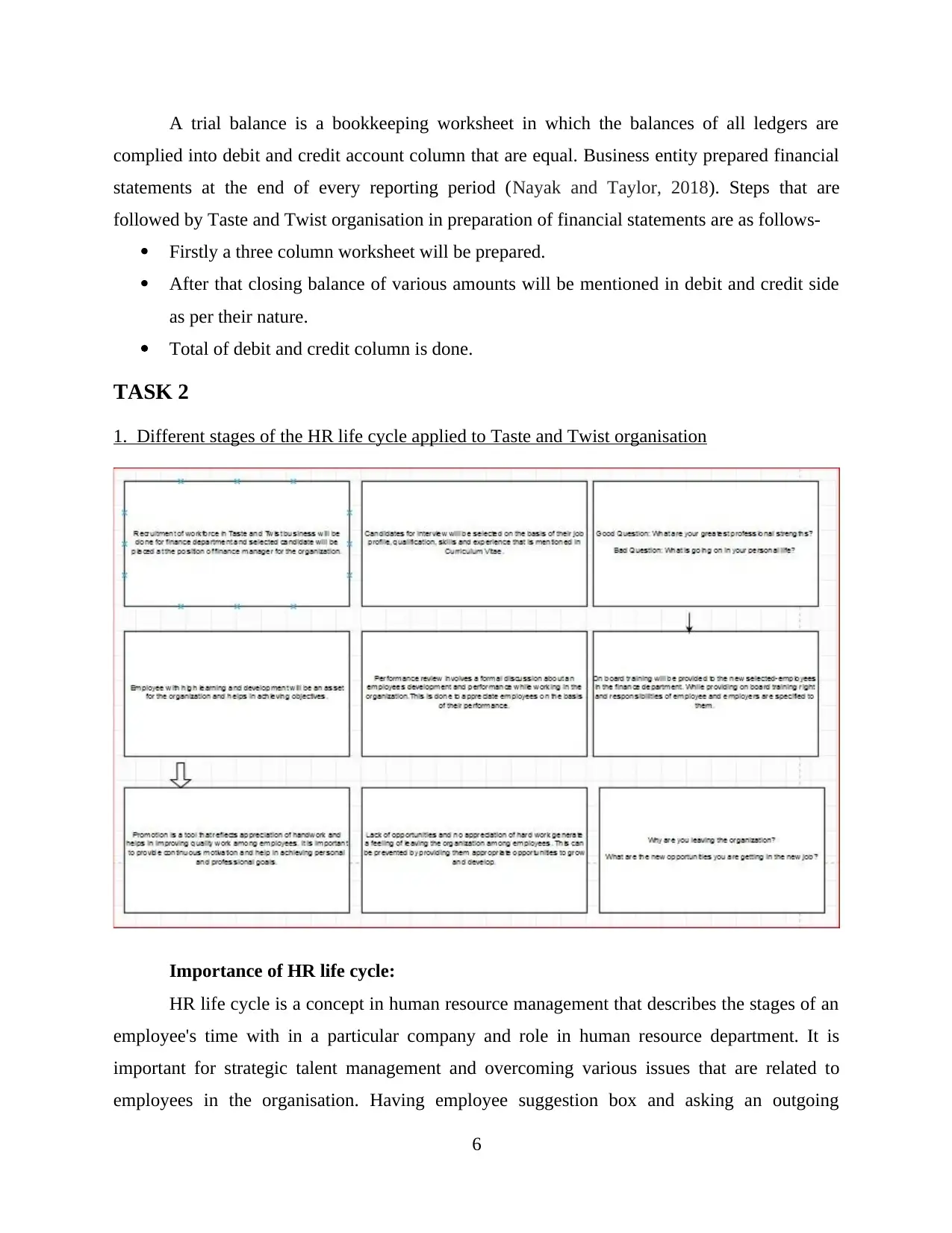
A trial balance is a bookkeeping worksheet in which the balances of all ledgers are
complied into debit and credit account column that are equal. Business entity prepared financial
statements at the end of every reporting period (Nayak and Taylor, 2018). Steps that are
followed by Taste and Twist organisation in preparation of financial statements are as follows-
Firstly a three column worksheet will be prepared.
After that closing balance of various amounts will be mentioned in debit and credit side
as per their nature.
Total of debit and credit column is done.
TASK 2
1. Different stages of the HR life cycle applied to Taste and Twist organisation
Importance of HR life cycle:
HR life cycle is a concept in human resource management that describes the stages of an
employee's time with in a particular company and role in human resource department. It is
important for strategic talent management and overcoming various issues that are related to
employees in the organisation. Having employee suggestion box and asking an outgoing
6
complied into debit and credit account column that are equal. Business entity prepared financial
statements at the end of every reporting period (Nayak and Taylor, 2018). Steps that are
followed by Taste and Twist organisation in preparation of financial statements are as follows-
Firstly a three column worksheet will be prepared.
After that closing balance of various amounts will be mentioned in debit and credit side
as per their nature.
Total of debit and credit column is done.
TASK 2
1. Different stages of the HR life cycle applied to Taste and Twist organisation
Importance of HR life cycle:
HR life cycle is a concept in human resource management that describes the stages of an
employee's time with in a particular company and role in human resource department. It is
important for strategic talent management and overcoming various issues that are related to
employees in the organisation. Having employee suggestion box and asking an outgoing
6
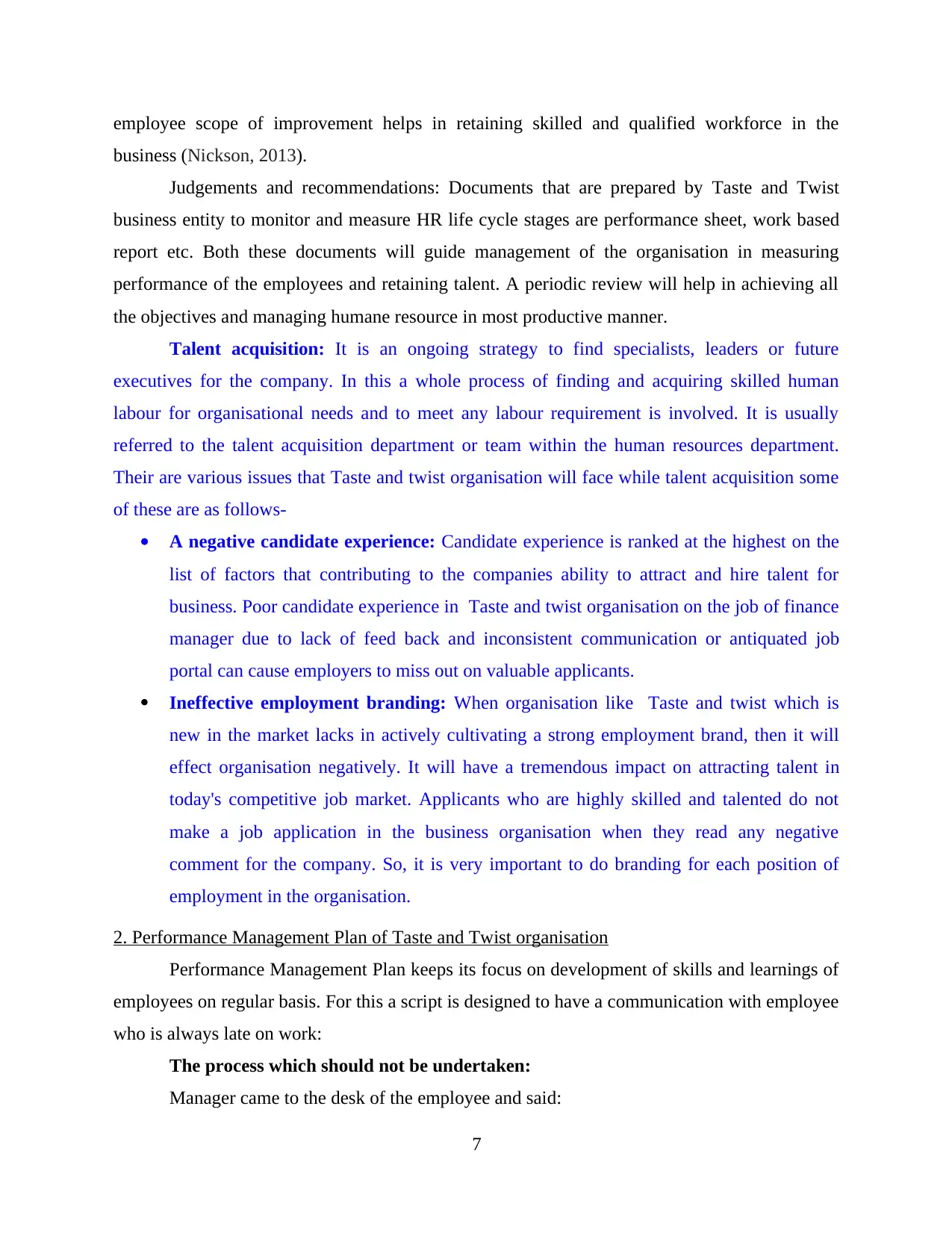
employee scope of improvement helps in retaining skilled and qualified workforce in the
business (Nickson, 2013).
Judgements and recommendations: Documents that are prepared by Taste and Twist
business entity to monitor and measure HR life cycle stages are performance sheet, work based
report etc. Both these documents will guide management of the organisation in measuring
performance of the employees and retaining talent. A periodic review will help in achieving all
the objectives and managing humane resource in most productive manner.
Talent acquisition: It is an ongoing strategy to find specialists, leaders or future
executives for the company. In this a whole process of finding and acquiring skilled human
labour for organisational needs and to meet any labour requirement is involved. It is usually
referred to the talent acquisition department or team within the human resources department.
Their are various issues that Taste and twist organisation will face while talent acquisition some
of these are as follows-
A negative candidate experience: Candidate experience is ranked at the highest on the
list of factors that contributing to the companies ability to attract and hire talent for
business. Poor candidate experience in Taste and twist organisation on the job of finance
manager due to lack of feed back and inconsistent communication or antiquated job
portal can cause employers to miss out on valuable applicants.
Ineffective employment branding: When organisation like Taste and twist which is
new in the market lacks in actively cultivating a strong employment brand, then it will
effect organisation negatively. It will have a tremendous impact on attracting talent in
today's competitive job market. Applicants who are highly skilled and talented do not
make a job application in the business organisation when they read any negative
comment for the company. So, it is very important to do branding for each position of
employment in the organisation.
2. Performance Management Plan of Taste and Twist organisation
Performance Management Plan keeps its focus on development of skills and learnings of
employees on regular basis. For this a script is designed to have a communication with employee
who is always late on work:
The process which should not be undertaken:
Manager came to the desk of the employee and said:
7
business (Nickson, 2013).
Judgements and recommendations: Documents that are prepared by Taste and Twist
business entity to monitor and measure HR life cycle stages are performance sheet, work based
report etc. Both these documents will guide management of the organisation in measuring
performance of the employees and retaining talent. A periodic review will help in achieving all
the objectives and managing humane resource in most productive manner.
Talent acquisition: It is an ongoing strategy to find specialists, leaders or future
executives for the company. In this a whole process of finding and acquiring skilled human
labour for organisational needs and to meet any labour requirement is involved. It is usually
referred to the talent acquisition department or team within the human resources department.
Their are various issues that Taste and twist organisation will face while talent acquisition some
of these are as follows-
A negative candidate experience: Candidate experience is ranked at the highest on the
list of factors that contributing to the companies ability to attract and hire talent for
business. Poor candidate experience in Taste and twist organisation on the job of finance
manager due to lack of feed back and inconsistent communication or antiquated job
portal can cause employers to miss out on valuable applicants.
Ineffective employment branding: When organisation like Taste and twist which is
new in the market lacks in actively cultivating a strong employment brand, then it will
effect organisation negatively. It will have a tremendous impact on attracting talent in
today's competitive job market. Applicants who are highly skilled and talented do not
make a job application in the business organisation when they read any negative
comment for the company. So, it is very important to do branding for each position of
employment in the organisation.
2. Performance Management Plan of Taste and Twist organisation
Performance Management Plan keeps its focus on development of skills and learnings of
employees on regular basis. For this a script is designed to have a communication with employee
who is always late on work:
The process which should not be undertaken:
Manager came to the desk of the employee and said:
7
⊘ This is a preview!⊘
Do you want full access?
Subscribe today to unlock all pages.

Trusted by 1+ million students worldwide

Manager: John, its been a month I am noticing that you are always late for the work. I
don not have any issue but management may have.
Employee: Sir, I will look after about management team.
Manager: OK, then its fine for me.
Manager: Yes sir.
The process which should be undertaken:
Manager called employee in the office room and said:
Manager: Its been so long and you are still irregular about office timings. Why?
Employee: There is a personal issue going on at my home.
Manager: This can not be tolerated in the office, I need to talk to HR about this.
Employee: Sir, I will try to resolve this in short while.
Manager: OK, you may go now.
TASK 3
1. Specific legislations that Taste and Twist organisation has to comply and adhere to
Covered in PPT
2. Impact of company, employment and contract law on business
Covered in PPT
TASK 4
1. Interrelation of functional roles within the hospitality industry
Organisational structure of Taste and Twist organisation is as follows:
8
don not have any issue but management may have.
Employee: Sir, I will look after about management team.
Manager: OK, then its fine for me.
Manager: Yes sir.
The process which should be undertaken:
Manager called employee in the office room and said:
Manager: Its been so long and you are still irregular about office timings. Why?
Employee: There is a personal issue going on at my home.
Manager: This can not be tolerated in the office, I need to talk to HR about this.
Employee: Sir, I will try to resolve this in short while.
Manager: OK, you may go now.
TASK 3
1. Specific legislations that Taste and Twist organisation has to comply and adhere to
Covered in PPT
2. Impact of company, employment and contract law on business
Covered in PPT
TASK 4
1. Interrelation of functional roles within the hospitality industry
Organisational structure of Taste and Twist organisation is as follows:
8
Paraphrase This Document
Need a fresh take? Get an instant paraphrase of this document with our AI Paraphraser
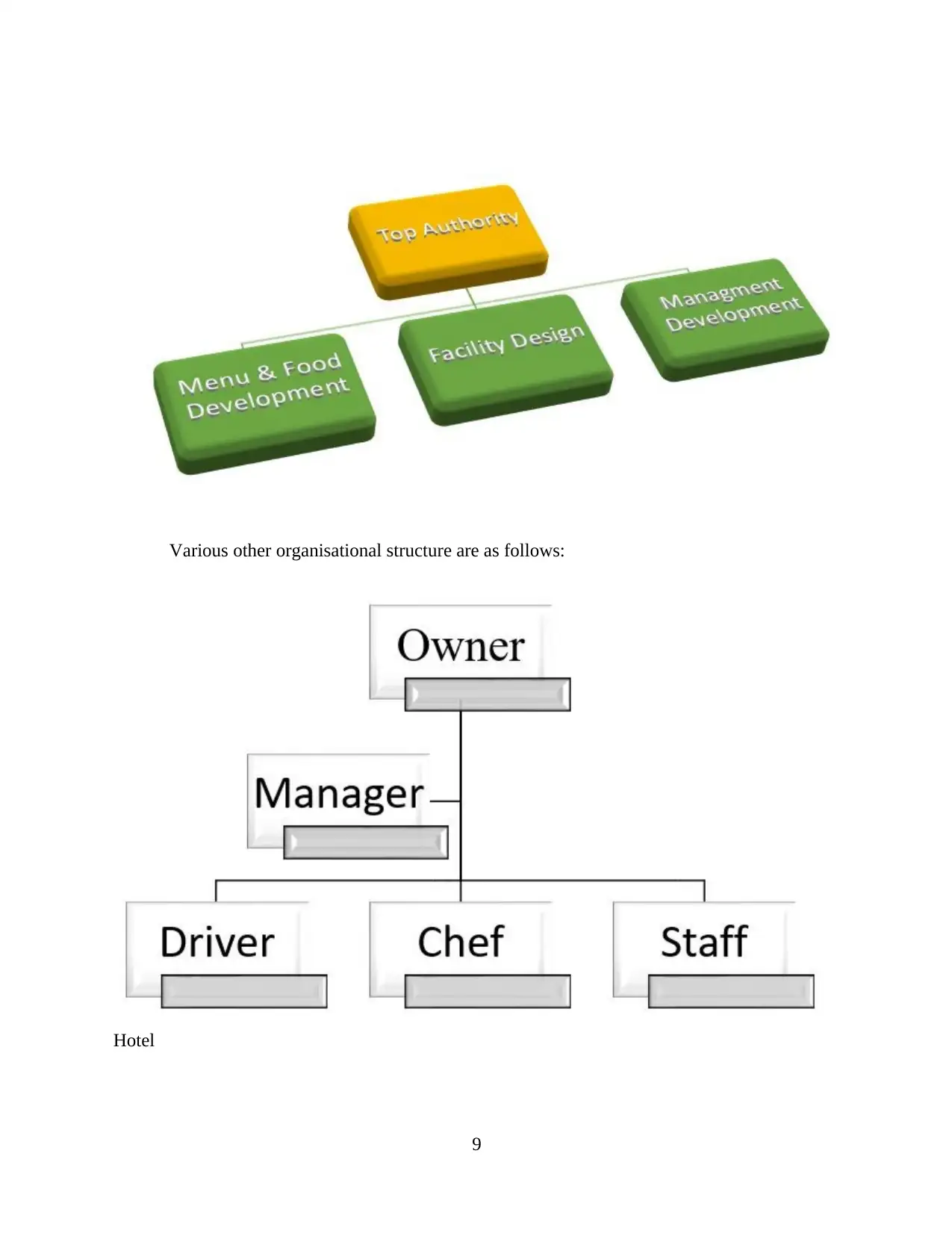
Various other organisational structure are as follows:
Hotel
9
Hotel
9
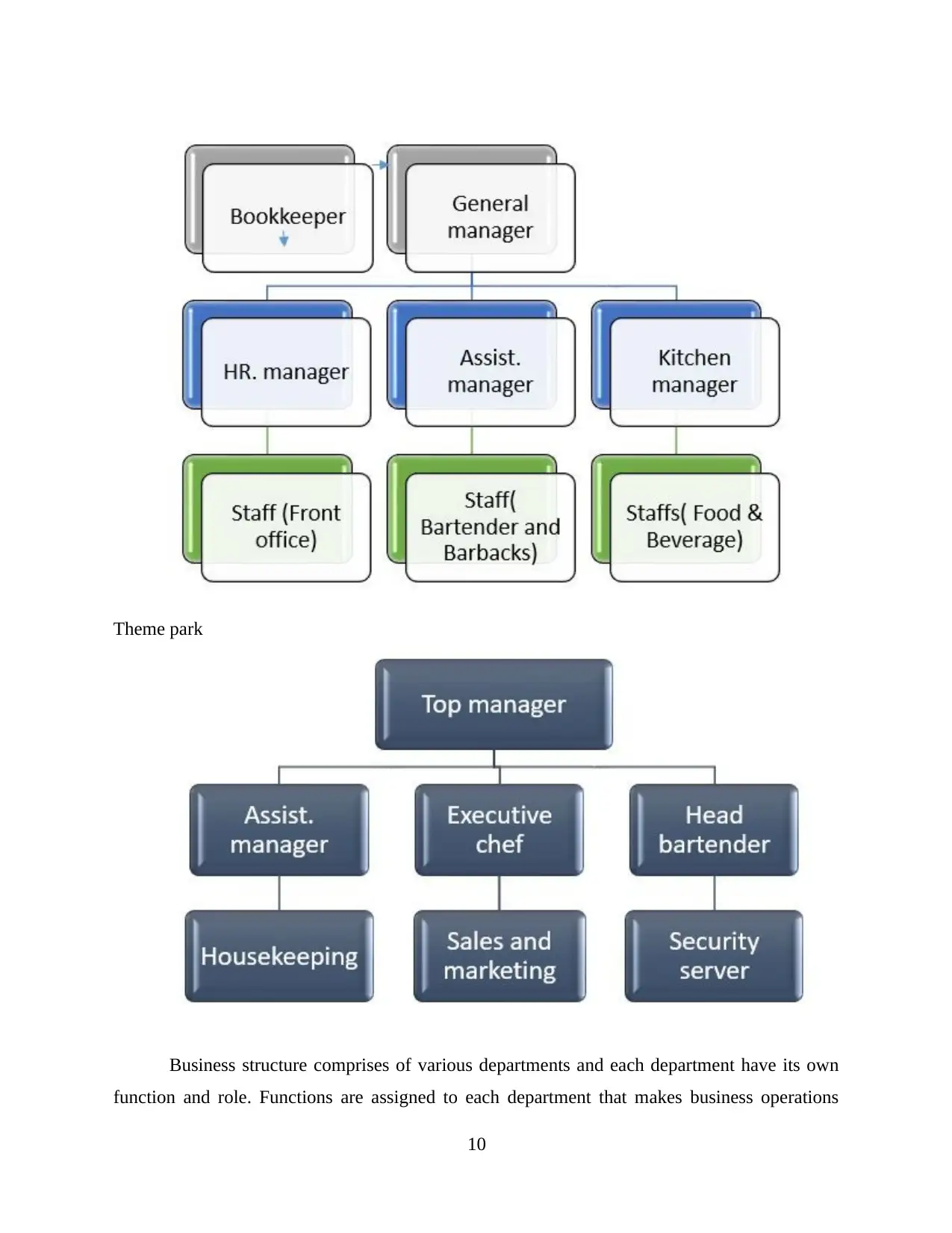
Theme park
Business structure comprises of various departments and each department have its own
function and role. Functions are assigned to each department that makes business operations
10
Business structure comprises of various departments and each department have its own
function and role. Functions are assigned to each department that makes business operations
10
⊘ This is a preview!⊘
Do you want full access?
Subscribe today to unlock all pages.

Trusted by 1+ million students worldwide
1 out of 16
Related Documents
Your All-in-One AI-Powered Toolkit for Academic Success.
+13062052269
info@desklib.com
Available 24*7 on WhatsApp / Email
![[object Object]](/_next/static/media/star-bottom.7253800d.svg)
Unlock your academic potential
Copyright © 2020–2026 A2Z Services. All Rights Reserved. Developed and managed by ZUCOL.





